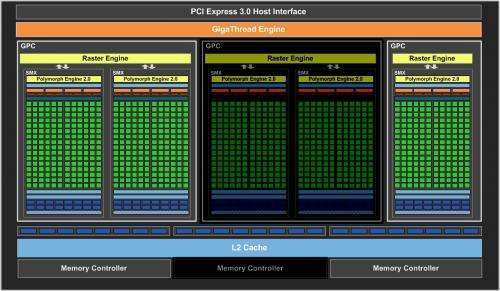September 24, 2012 weblog
Specs for Nvidia GeForce GTX 650 Ti graphics card leaked

(Phys.org)—Rumors are swirling around the internet concerning Nvidia's follow-up to its announcement last week of the GeForce GTX 650 and GTX 660, that a GeForce GTX 650 Ti graphics card is next and that it will fill in between the other two. Graphics cards and their specifications are important to gamers because the higher the quality, the better the gaming experience. Some run fast but produce less than sharp or rich images, while some are the opposite. The best produce razor sharp, fully textured images, with no blurring or skipping during motion sequences. To create stunning visuals for video games, graphics card makers such as Nvidia have developed processors with a variety of hardware options that offer trade-offs between price and performance. The GeForce GTX 650 Ti appears to be the ultimate trade-off, sacrificing processing speed for price, but only to a certain degree.
The latest is that the GeForce GTX 650 Ti is to be based on the same Graphics Processing Unit (GPU) as the GTX 660 (GK106), though sadly, will have two of its five SMX (streaming multiprocessor) units disabled, which will of course slow down its processing abilities. It will also have one of its memory controllers disabled as well. The idea is to give gamers a card that costs less than the 660 (average price $230), but offers more performance than the 650 (average price $109). The rumor is that the newest addition to the line will cost on average $170. The 650 Ti also will have a smaller bus and fewer texture units than the 660 and of course a reduced clock speed, which when added together would seem to bring the performance of the new card closer to the 650 than the 660.
Hardware specs and numbers are helpful in gauging how a graphics card will perform, but the ultimate test is how things look when the card is installed and operating, and most appear to expect the GeForce GTX 650 Ti to perform somewhat faster than the 650, but quite a bit slower than the 660, and that image quality will fall somewhere in-between as well (texture units for example, are believed to be 48, versus 80 for the 660 and 32 for the 650). Thus, the bottom line for gamers will be to decide if the $60 difference between the 650 Ti and the 660 is worth wringing their hands over.
© 2012 Phys.org



















